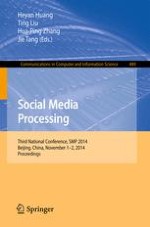2014 | Buch
Social Media Processing
Third National Conference, SMP 2014, Beijing, China, November 1-2, 2014. Proceedings
herausgegeben von: Heyan Huang, Ting Liu, Hua-Ping Zhang, Jie Tang
Verlag: Springer Berlin Heidelberg
Buchreihe : Communications in Computer and Information Science
